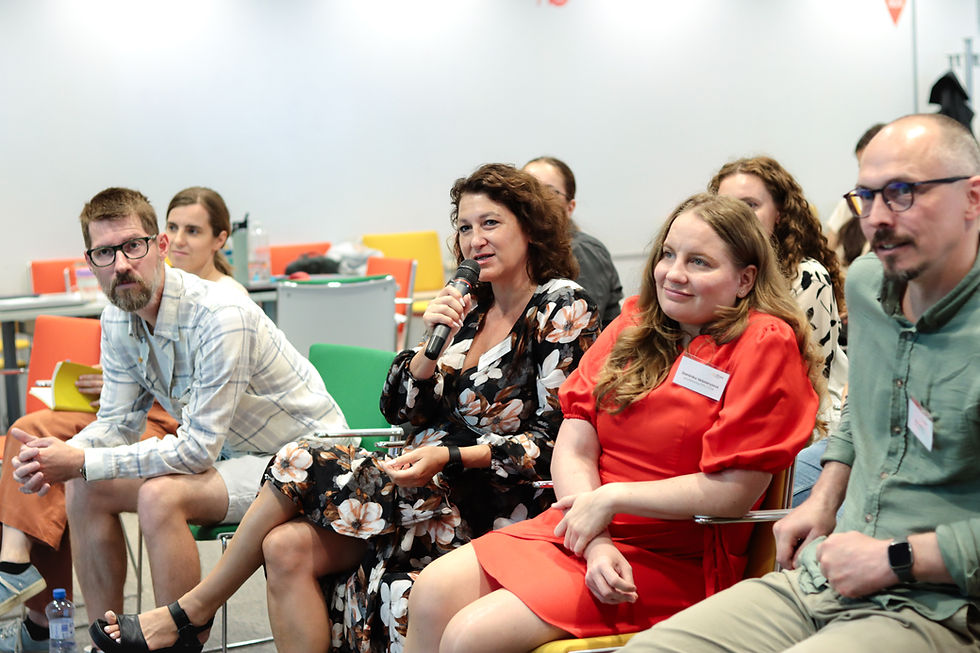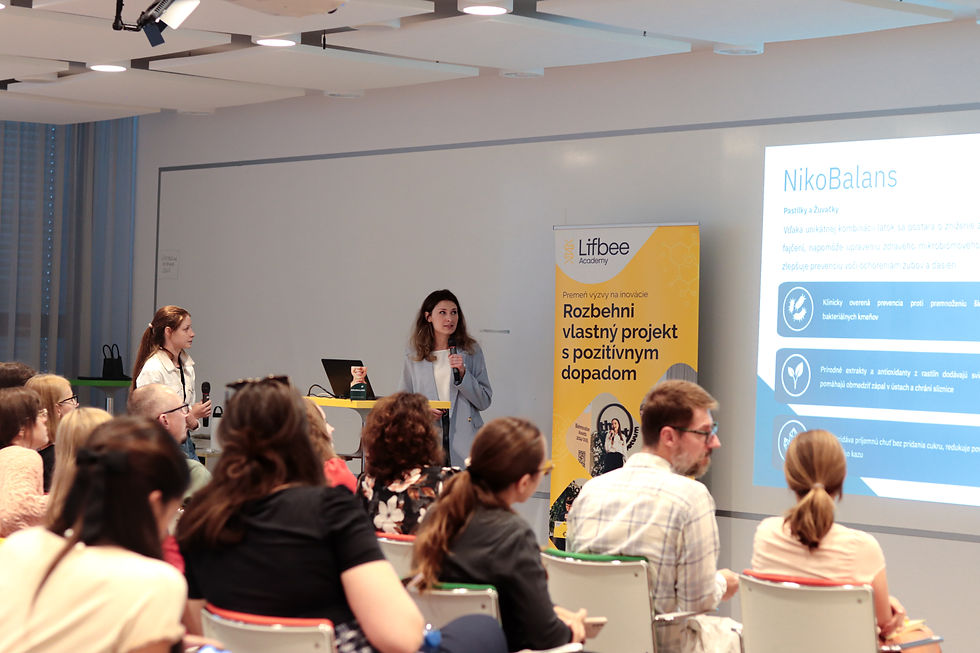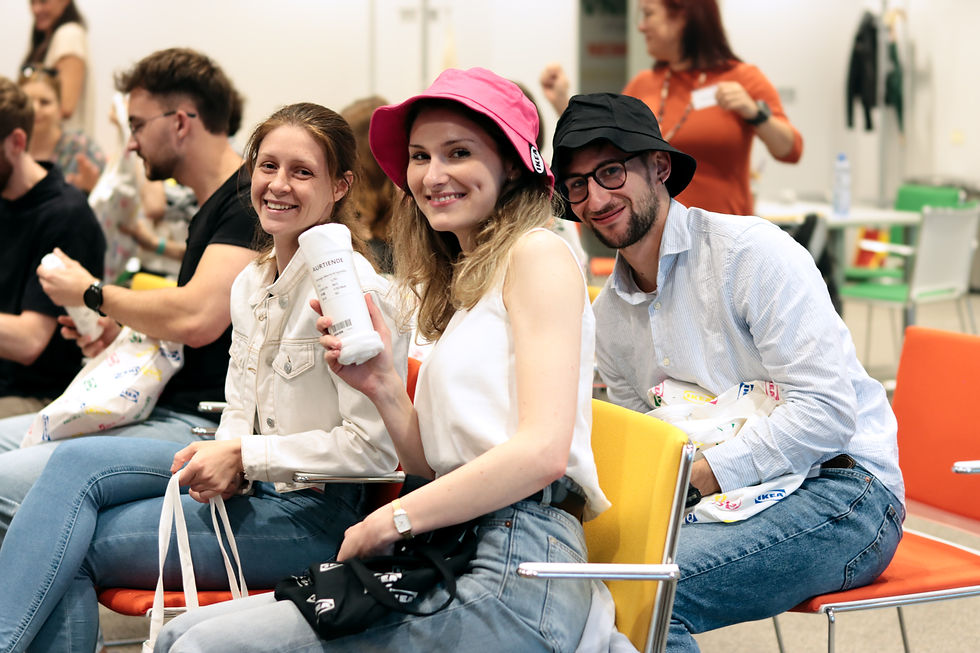From Laboratory to Market: How UCM and Lifbee Jointly Test a New Innovation Model
- simona884
- Aug 19
- 4 min read
In Slovakia, it is not common for university research and external innovation teams to join forces in a joint experiment.
The Faculty of Natural Sciences at UCM in Trnava and Lifbee Academy did just that this year, creating the Summer Hackathon, which demonstrated the power of this model.
The university brought years of work by its research teams and an openness to look at them from a new angle. Lifbee Academy brought 31 young innovators, half of whom wanted to try out how the cutting-edge knowledge created at the Faculty of Natural Sciences could be used to create products and services with a real impact.
The result was solutions that combine scientific depth with practical relevance – and thanks to this inspiration, scientists have the potential and opportunity to direct their research towards solving global problems.

During the event, we were able to work in an inspiring space thanks to the support of VÚB Bank. The hackathon was also supported by Lifbee Academy ENVI-PAK, a long-term partner, and IKEA sponsored the food and refreshments. Together, they created the ideal conditions for innovators to get fully immersed in their work, develop their innovative skills, and bring inspiration to university research. So what came out of it?
1️⃣ Smoking and the oral microbiome: how to turn science into a product that helps
UCM research has shown that young smokers aged 18–26 already have higher levels of a biomarker associated with inflammation (N-acetylcadaverine) in their saliva than non-smokers. They also have elevated levels of other biomarkers related to oxidative stress, inflammatory response, and cell proliferation. In addition, they experience more frequent inflammation of the oral cavity, breathing difficulties, and digestive problems. One of the reasons identified is a disturbed oral microbiome—beneficial bacteria and microorganisms that support the homeostasis of the oral cavity.
The hackathon team, consisting of oncology student Katarína Buranovská, scientist Lenka Trnková, computer science student Patrik Kozlík, and computer science student Peter Hubina, conducted a survey of 154 smokers and found that problems such as coughing, dry mouth, and bad breath are mostly solved by chewing gum.
This led to inspiration, and the idea of probiotic chewing gum with a unique composition that restores a healthy oral microbiome and reduces inflammation appeared on the table. A product that doesn't alienate, but helps – and could appeal to millions of smokers around the world.

2️⃣ Viruses in vineyards: protecting crops in the era of climate change
The faculty's second area of research focuses on grapevine viruses and viroids – tiny, often invisible organisms that can silently decimate entire vineyards. Losses can run into the millions, and growers often learn about the infection too late..

A team of innovators from Lifbee Academy, consisting of product manager Péter Stingel, lead developer Michal Ondrejička, future innovator Marek Kucej, and PhD medical student Filip Jura, have designed a solution that combines CRISPR-Dx technology with artificial intelligence. The grower takes a sample, evaluates it on the spot, and gets the result immediately. The data is also stored in a database that maps the occurrence of specific viruses and viroids, enabling better planning and prevention. Such a platform could fundamentally change the way winegrowers protect their vineyards – not only in Slovakia, but in all wine-growing regions of the world.

3️⃣Natural sciences and Generation Z: attracting future crisis solvers
Climate change, biodiversity loss, pollution – challenges that will define the 21st century. Only the professions that Generation Z is increasingly less likely to pursue can solve them.
The third hackathon task was: How to show young people that studying natural sciences is a path to real impact?
The team developed a strategy based on authentic student stories, visually appealing content, and communication where young people are – on Instagram and TikTok. The goal is to transform faculties into places where not only theory is born, but also solutions to the crises that young people perceive on a daily basis.
Thanks to this approach, studying natural sciences can become more attractive, understandable, and closer to the needs of today's generation. Faculties that can combine quality education with inspiring communication and storytelling have great potential to attract a new wave of enthusiastic scientists.
The topic was worked on jointly by Vadym Palchyk, a student of strategy and business, Sophia Červenáková, a student of biomedicine, and Danica Ivovic, a postdoctoral researcher.

Why is this a collaboration worth following?
These three projects prove that scientific precision and market thinking can be combined in Slovakia – and the results can spread from here to the rest of the world.
This hackathon was an experiment, but also a demonstration that when the openness of a university and the energy of innovators come together, basic research can be transformed into projects with global potential. It is proof that science and innovation do not have to run in separate worlds – and that Slovakia can be part of connecting these two worlds.
Another similar event could be an opportunity for you as well – whether you are a researcher, student, partner, or someone who wants to be part of creating new solutions. Momentum is here. And it would be a shame to miss it. That’s why you should follow Lifbee Academy and the Faculty of Natural Sciences at UCM, or directly apply to the programs they offer.








Comments